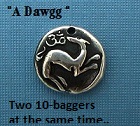Rocky Mountains Originated from Previously Unknown
Post# of 63902

Rocky Mountains Originated from Previously Unknown Oceanic Plate
Apr. 3, 2013 — The mountain ranges of the North American Cordillera are made up of dozens of distinct crustal blocks. A new study clarifies their mode of origin and identifies a previously unknown oceanic plate that contributed to their assembly.

Canadian wilderness with Rocky Mountains, Alberta, Canada.
The extensive area of elevated topography that dominates the Western reaches of North America is exceptionally broad, encompassing the coastal ranges, the Rocky Mountains and the high plateaus in between. In fact, this mountain belt consists of dozens of crustal blocks of varying age and origin, which have been welded onto the American continent over the past 200 million years. "How these blocks arrived in North America has long been a puzzle," says LMU geophysicist Karin Sigloch, who has now taken a closer look at the problem, in collaboration with the Canadian geologist Mitchell Mihalynuk.
Collisions and continental growth
One popular model for the accretion process postulates that a huge oceanic plate -- the Farallon Plate -- acted as a conveyor belt to sweep crustal fragments eastwards to the margin of American Plate, to which they were attached as the denser Farallon Plate was subducted under it. However, this scenario is at variance with several geological findings, and does not explain why the same phenomenon is not observed on the west coast of South America, the classical case of subduction of oceanic crust beneath a continental plate. The precise source of the crustal blocks themselves has also remained enigmatic, although geological studies suggest that they derive from several groups of volcanic islands. "The geological strata in North America have been highly deformed over the course of time, and are extremely difficult to interpret, so these findings have not been followed up," says Sigloch.
Sigloch and Mihalynuk have now succeeded in assembling a comprehensive picture of the accretion process by incorporating geophysical findings obtained by seismic tomography. This technique makes it possible to probe the geophysical structure of Earth's interior down to the level of the lower mantle by analyzing the propagation velocities of seismic waves. The method can image the remnants of ancient tectonic plates at great depths, ocean floor that subducted, i.e., disappeared from the surface and sank back into the mantle, long time ago.
Intra-oceanic subduction of the Farallon Plate
Most surprisingly, the new data suggest that the Farallon Plate was far smaller than had been assumed, and underwent subduction well to the west of what was then the continental margin of North America. Instead it collided with, and subducted under, an intervening and previously unrecognized oceanic plate. Sigloch and Mihalynuk were able to locate the remnants of several deep-sea trenches that mark subduction sites at which oceanic plates plunge at a steep angle into the mantle and are drawn almost vertically into its depths. "The volcanic activity that accompanies the subduction process will have generated lots of new crustal material, which emerged in the form of island arcs along the line of the trenches, and provided the material for the crustal blocks," Sigloch explains.
As these events were going on, the American Plate was advancing steadily westwards, as indicated by striped patterns of magnetized seafloor in the North Atlantic. The first to get consumed was the previously unknown oceanic plate, which can be detected seismologically beneath today's east coast of North America. Only then did the continent begin to encounter the Farallon plate. On its westward journey, North America overrode one intervening island arc after another -- annexing ever more of them for the construction of its wide mountains of the West.
 (0)
(0) (0)
(0)